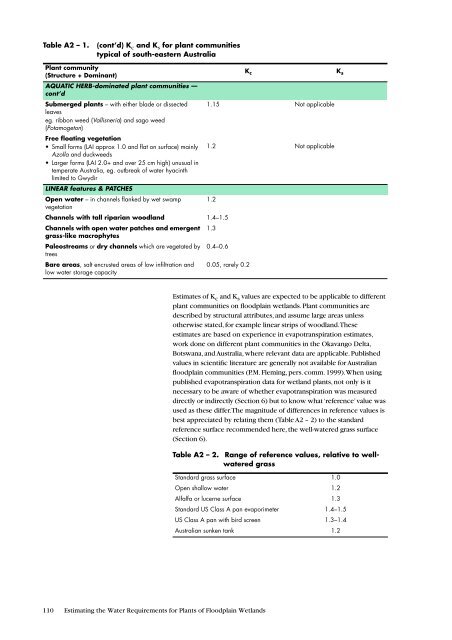Estimating the Water Requirements for Plants of Floodplain Wetlands
Estimating the Water Requirements for Plants of Floodplain Wetlands
Estimating the Water Requirements for Plants of Floodplain Wetlands
Create successful ePaper yourself
Turn your PDF publications into a flip-book with our unique Google optimized e-Paper software.
Table A2 – 1.(cont’d) K c and K s <strong>for</strong> plant communitiestypical <strong>of</strong> south-eastern AustraliaPlant community(Structure + Dominant)AQUATIC HERB-dominated plant communities —cont’dSubmerged plants – with ei<strong>the</strong>r blade or dissectedleaveseg. ribbon weed (Vallisneria) and sago weed(Potamogeton)Free floating vegetation• Small <strong>for</strong>ms (LAI approx 1.0 and flat on surface) mainlyAzolla and duckweeds• Larger <strong>for</strong>ms (LAI 2.0+ and over 25 cm high) unusual intemperate Australia, eg. outbreak <strong>of</strong> water hyacinthlimited to GwydirLINEAR features & PATCHESOpen water – in channels flanked by wet swamp 1.2vegetationChannels with tall riparian woodland 1.4–1.5Channels with open water patches and emergent 1.3grass-like macrophytesPaleostreams or dry channels which are vegetated by 0.4–0.6treesBare areas, salt encrusted areas <strong>of</strong> low infiltration and 0.05, rarely 0.2low water storage capacityK c1.15 Not applicable1.2 Not applicableK sEstimates <strong>of</strong> K c and K s values are expected to be applicable to differentplant communities on floodplain wetlands. Plant communities aredescribed by structural attributes, and assume large areas unlesso<strong>the</strong>rwise stated, <strong>for</strong> example linear strips <strong>of</strong> woodland. Theseestimates are based on experience in evapotranspiration estimates,work done on different plant communities in <strong>the</strong> Okavango Delta,Botswana, and Australia, where relevant data are applicable. Publishedvalues in scientific literature are generally not available <strong>for</strong> Australianfloodplain communities (P.M. Fleming, pers. comm. 1999). When usingpublished evapotranspiration data <strong>for</strong> wetland plants, not only is itnecessary to be aware <strong>of</strong> whe<strong>the</strong>r evapotranspiration was measureddirectly or indirectly (Section 6) but to know what ‘reference’ value wasused as <strong>the</strong>se differ. The magnitude <strong>of</strong> differences in reference values isbest appreciated by relating <strong>the</strong>m (Table A2 – 2) to <strong>the</strong> standardreference surface recommended here, <strong>the</strong> well-watered grass surface(Section 6).Table A2 – 2. Range <strong>of</strong> reference values, relative to wellwateredgrassStandard grass surface 1.0Open shallow water 1.2Alfalfa or lucerne surface 1.3Standard US Class A pan evaporimeter 1.4–1.5US Class A pan with bird screen 1.3–1.4Australian sunken tank 1.2110 <strong>Estimating</strong> <strong>the</strong> <strong>Water</strong> <strong>Requirements</strong> <strong>for</strong> <strong>Plants</strong> <strong>of</strong> <strong>Floodplain</strong> <strong>Wetlands</strong>
















